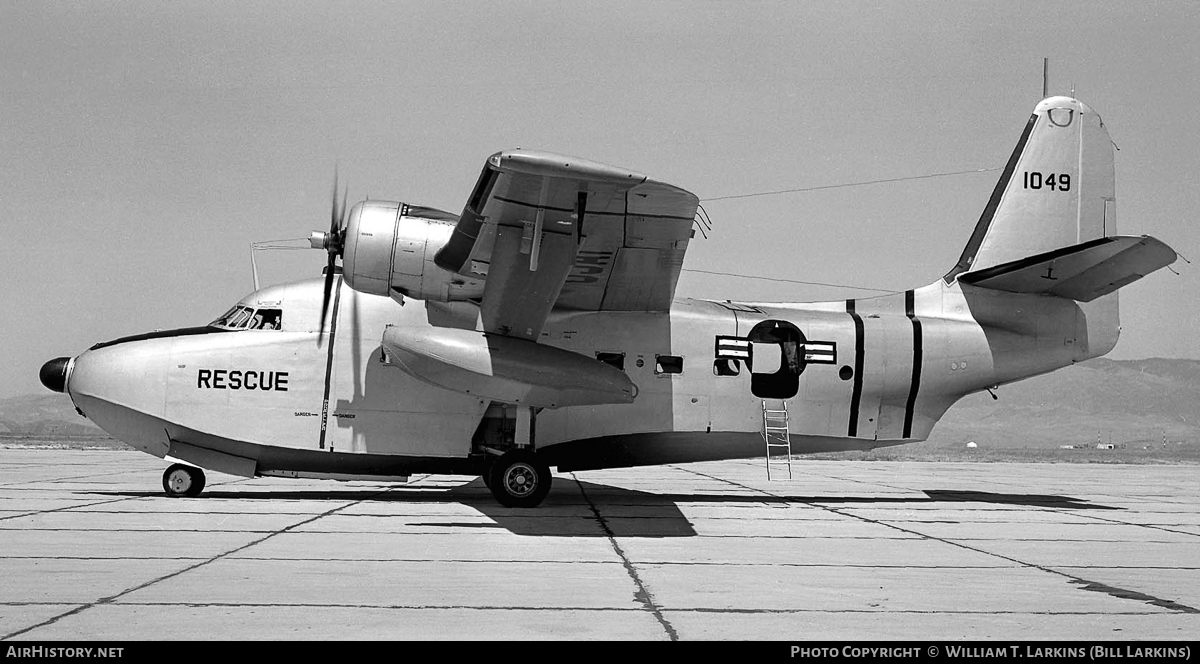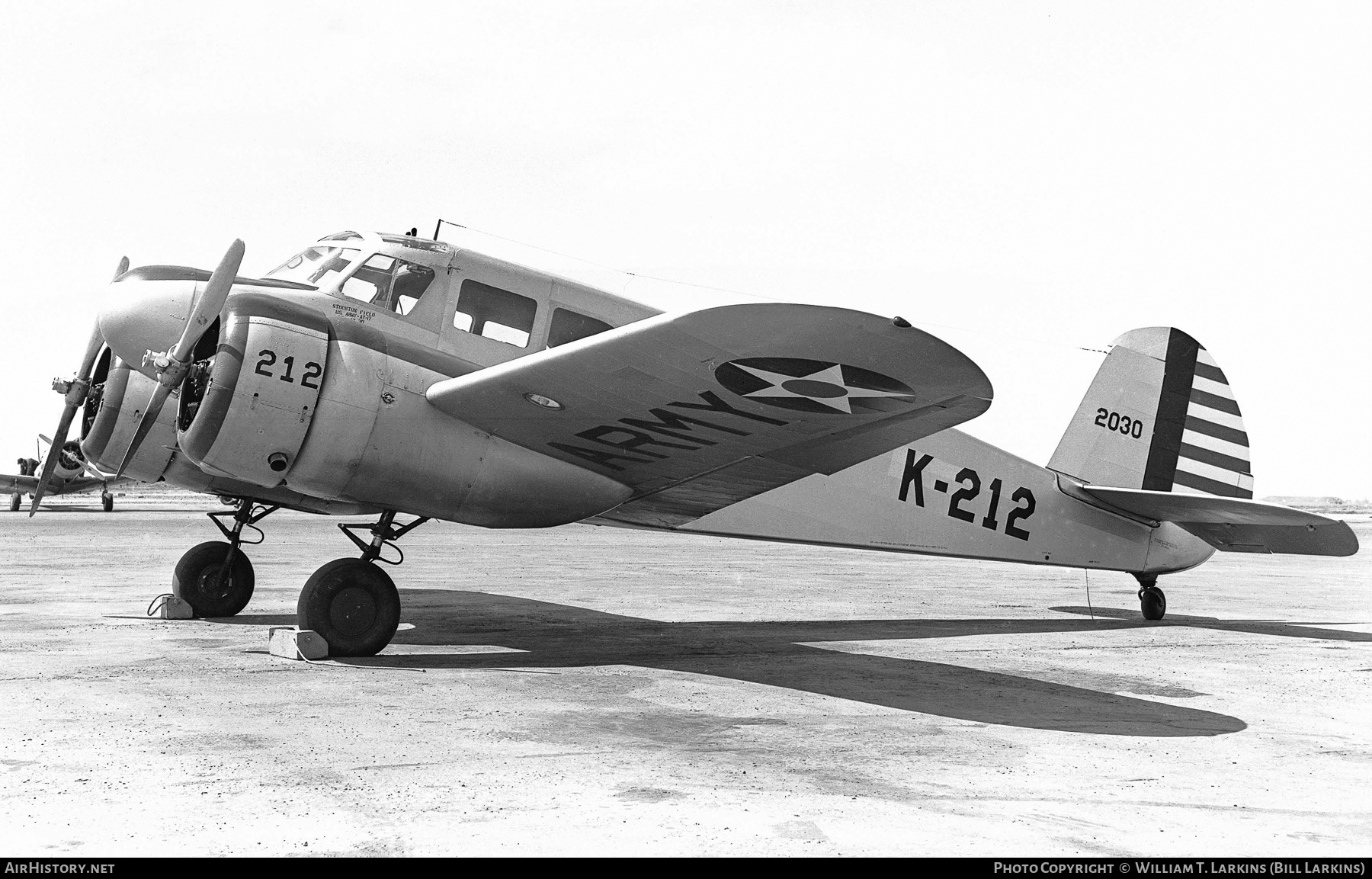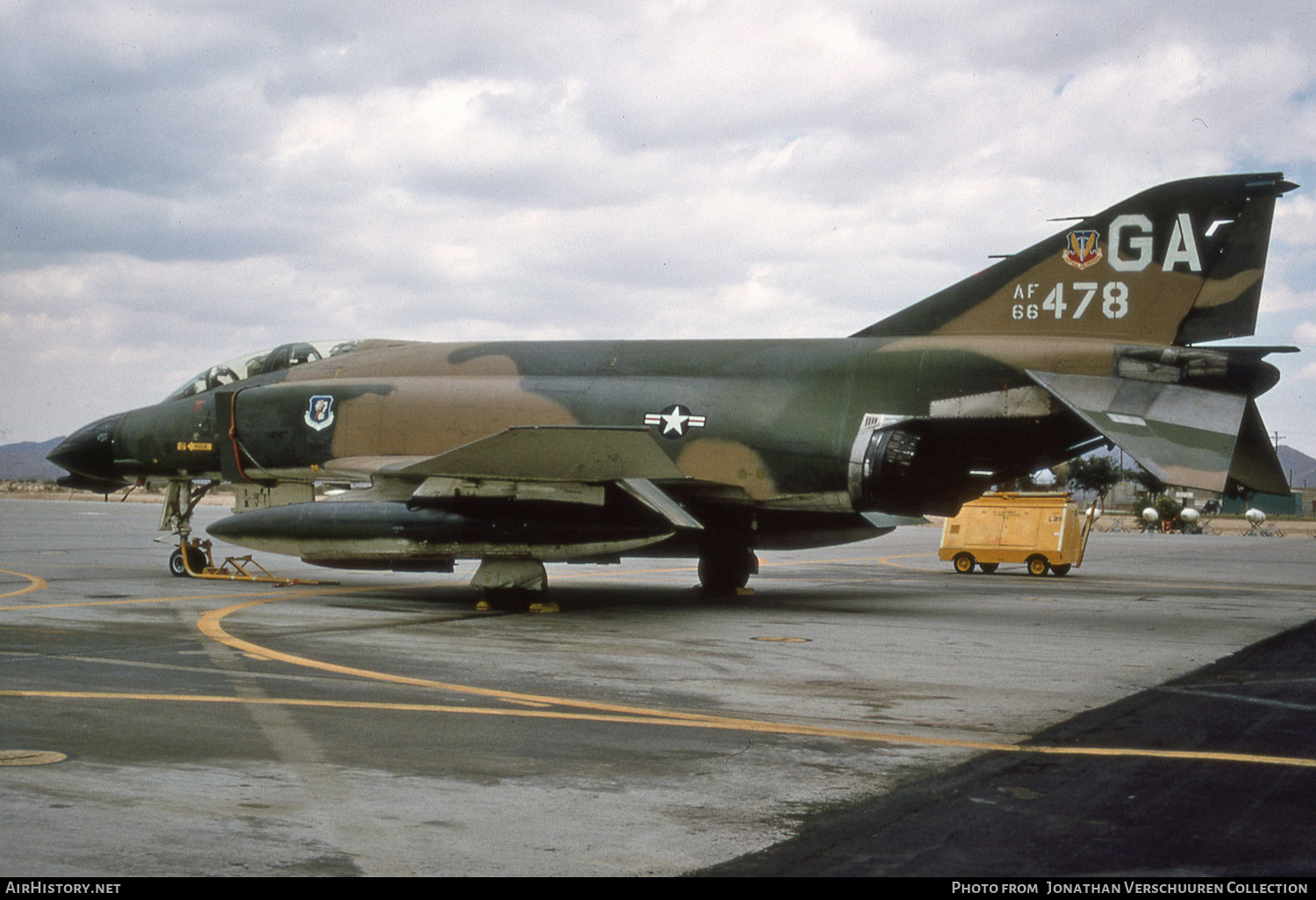USAF and US Army serial and tail numbers
The ins and outs
By Aad van der Voet, Peter de Jong and Peter Vercruijsse20 August 2023
Whether you're into jet fighters or classic propliners, as an aviation enthusiast you are probably more or less familiar with the year-based serial system that the US Army and US Air Force have used to uniquely identify their aircraft for over 100 years now. It is basically pretty straightforward but does have its pitfalls, generally due to sticking to a 1941 decision to paint serials on the tails of the aircraft in a truncated form.
A US Air Force SA-16A Albatross 51-049 at Boise, Idaho, in August 1952. The short tail number correctly reflects the full serial, 51-049.
Photo: William T. Larkins (Bill Larkins)
On 1 August 1907, the Aeronautical Division of the United States Army Signal Corps was established. This became the United States Army Air Service (USAAS) on 24 May 1918, then the United States Army Air Corps (USAAC) on 2 July 1926, then the United States Army Air Force (USAAF) on 20 June 1941, and finally the United States Air Force (USAF) on 18 September 1947.
In the early days, every Army aircraft received a simple sequential number, aptly called the serial number. The first aircraft, a Wright Model A purchased in 1908, was brought on charge in early 1909 with the serial number 1. Initially all serial numbers were sequential, in order of purchase (which is not necessarily the order of delivery), but after a while certain serial number blocks were introduced. The 200 block was reserved for seaplanes, the 40000 block for experimental aircraft, and the 94000 block for prototypes and aircraft still under evaluation. Within each block, the numbers were still issued sequentially.
When painted on the aircraft, these serial numbers were often prefixed by 'S.C.' (for Signal Corps), 'A.S.' (for Air Service) or 'A.C.' (for Air Corps), depending on the name of the service at that time. However, these prefix letters were not part of the actual serial number and were dropped in 1932.
Enter the fiscal year
On 1 July 1921, at the start of the US Government's fiscal year 1922, an important change to the numbering system was introduced. The numbers were still sequential, but they were now prefixed by the last two digits of the fiscal year in which the aircraft was ordered (not when it was delivered!). This fiscal year prefix was officially called the base number. For each new fiscal year, the sequential number was to start again at 1. The first aircraft to be assigned a new style serial number was a Sperry M-1, serialled 22-1 and painted as 'A.S. 22-1'.
Fiscal years then ran from 1 July of the previous calendar year to 30 June. For example, the fiscal year 1942 started on 1 July 1941 and ended on 30 June 1942. For completeness, it should be noted that this changed in 1976: the US fiscal year now runs from 1 October of the previous calendar year until 30 September.
The Technical Data Block
An unfortunate development for us enthusiasts occurred in the early 1930s. Before then, the aircraft serial numbers were painted in a fair size on each side of the fuselage, making aircraft identification easy. But the introduction of the Technical Data Block in 1932 put an end to that. The serial number was reduced in height to a mere 2.5 cm (1 inch), and only displayed in this Technical Data Block (TDB) on the left side of the fuselage, near the cockpit.
Unit and base identification codes were now displayed in large letters on both sides of the fuselage or the fin. But because these codes were changeable, uniquely identifying an aircraft from a distance had now become very difficult or often even impossible.

From 1932, serial numbers were only worn in a very small size in the data block on the left side near the cockpit. The tail code of this C-39, a DC-2 with a DC-3 tailfin and wing centre section, signifies that this was aircraft 20 of the 62nd Transport Group, but this is not enough to identify it: we cannot know this aircraft's serial number or construction number.
Photo: William T. Larkins (Bill Larkins)
From 1932, serial numbers were only worn in a very small size in the data block on the left side near the cockpit. The tail code of this C-39, a DC-2 with a DC-3 tailfin and wing centre section, signifies that this was aircraft 20 of the 62nd Transport Group, but this is not enough to identify it: we cannot know this aircraft's serial number or construction number.
Photo: William T. Larkins (Bill Larkins)
For enthusiasts the data block offered only one minor advantage: it not only shows the aircraft's full serial number, but also the exact aircraft model and sometimes the aircraft's home base and military component.
Serial numbers in the data blocks often carried a suffix letter, the so-called Aircraft Component Assignment Letter. Not part of the serial itself, this suffix signified the component of the US military to which the aircraft had been assigned. Six letters were in use: A = US Air Force, G = US Army, M = US Air Attaches (aircraft based with embassies abroad), N = Air National Guard, R = Air Reserve, and T = Reserve Officers Training Course (ROTC).
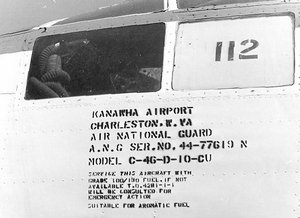
The Technical Data Block was shown on the left side of the aircraft, near the cockpit, as demonstrated here by C-46D 44-77619. The letter N following the serial is the Aircraft Component Assignment Letter, which in this case signifies that this aircraft had been assigned to the Air National Guard. From about 1932 to 1941, this data block was often the only way to uniquely identify an aircraft.
Photo: William T. Larkins (Bill Larkins)
The Technical Data Block was shown on the left side of the aircraft, near the cockpit, as demonstrated here by C-46D 44-77619. The letter N following the serial is the Aircraft Component Assignment Letter, which in this case signifies that this aircraft had been assigned to the Air National Guard. From about 1932 to 1941, this data block was often the only way to uniquely identify an aircraft.
Photo: William T. Larkins (Bill Larkins)
The data block is still in use today, now officially called the Aircraft Data Legend. By the early 1990s it was made even smaller – the letters are now only about 1.5 cm or 0.5 inch high – and moved to a new position near the ground refueling receptacle.
The Radio Call Number or tail number
Serials could be as short as '42-1' until 1947. The tail numbers were required to have at least four digits, with zeros added as needed. This is shown here by Cessna AT-17 Bobcat 42-30, which correctly received tail number 2030 instead of 230, with one 'padding zero' thrown in.
Photo: William T. Larkins (Bill Larkins)
Shortly after the restructuring of the USAAC into the United States Army Air Force (USAAF) on 20 June 1941, the problem of not being able to properly identify an aircraft from a distance was finally recognized. On 28 October 1941, Technical Order 07-1-1 was issued, titled Aircraft Camouflage, Markings and Insignia. T.O. 07-1-1 exactly defined the size and location of the insignia, serial numbers, tail numbers, code letters, technical data block and various other markings. In paragraph 17a, this document says:
Radio call numbers of not less than four numerals will be maintained on all AAF aircraft [...]. These will be applied to both sides or each outboard side, as applicable, of the vertical stabilizer and rudder assembly, except that on rotary winged aircraft, they will be applied to the sides of the fuselage. These call numbers, or designators, will be of a size discernible at a distance of 150 yards. The suggested minimum size is 8 x 12 inches. They will be derived by deletion of the first numeral of the serial number (4) and the hyphen (-), and the combination of the remaining four or more numerals. In case of serial numbers of type 41-7, use zero as necessary to make four numerals as 1007. Colors will be black for uncamouflaged surfaces, and yellow for camouflaged surfaces except that black camouflaged planes will have insignia red call numbers.
View the relevant part of the original document.
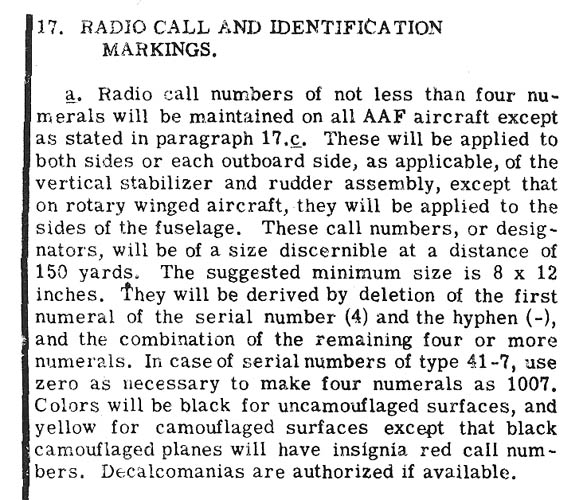
In plain English, the aircraft's unique serial number was now once again to be painted in a large size on each side of the vertical stabilizer. But it was now to be presented in an abbreviated form, officially called the radio call number, but referred to by most people as the tail number. With no aircraft then lasting in service for a decade or longer, one digit of the fiscal year could safely be omitted. The tail number thus was to show only the last digit of the fiscal year, immediately followed by the sequential number, leaving out the fiscal year decade digit and the separating dash.
The tail number was required to be at least four digits long (increased to at least five digits as of 1954). To reach this length, additional zeros had to be inserted in front of the sequential number.

During World War II, the USAAF procured so many aircraft that sequential numbers reached four digits in fiscal year 1940, five in 1941, and even six digits in 1942 and 1943. The first digit of the fiscal year was always a '4', so it made some sense then to leave it out of the tail numbers. These fiscal year 1944 Mustangs all have five-digit sequential numbers.
Photo: William T. Larkins (Bill Larkins)
During World War II, the USAAF procured so many aircraft that sequential numbers reached four digits in fiscal year 1940, five in 1941, and even six digits in 1942 and 1943. The first digit of the fiscal year was always a '4', so it made some sense then to leave it out of the tail numbers. These fiscal year 1944 Mustangs all have five-digit sequential numbers.
Photo: William T. Larkins (Bill Larkins)
On 18 September 1947, the USAAF was divided between the new United States Air Force (USAF) and the US Army. The serial number system remained in force for both the Air Force and the Army, with only one small change. From fiscal year 1947 'filler' or 'padding' zeros did not only occur in the tail numbers, but also in the full serial numbers, as the sequential numbers were now required to have at least three digits. This meant that the first fiscal year 1947 aircraft, a B-45A Tornado bomber, did not become 47-1, but 47-001. The full serial numbers of older aircraft were not adapted. In 1958 there was another change, requiring at least four digits for the sequential number. This system is still in use today.
To further clarify the above, some examples of actual serial numbers and their corresponding tail numbers are shown in the table below. Note that with each revision of the rules the tail numbers of older aircraft were changed retroactively, but the actual serial numbers were not.
| Fiscal Years | Requirements | Serial | Tail number |
|---|---|---|---|
| 1922-1931 | Full serial displayed No tail number Sequential number length undefined |
22-1 26-315 30-85 31-602 |
➔ none ➔ none ➔ none ➔ none |
| 1932-1940 | Full serial displayed in TDB only No tail number Sequential number length undefined |
33-163 36-1 39-36 40-3099 |
➔ none ➔ none ➔ none ➔ none |
| 1941-1946 | Tail number minimum 4 digits Sequential number length undefined |
39-17 40-70 40-3099 42-110188 46-2 |
➔ 9017 ➔ 0070 ➔ 3099 ➔ 2110188 ➔ 6002 |
| 1947-1953 | Tail number minimum 4 digits Sequential number minimum 3 digits |
46-2 51-099 51-7260 52-10545 |
➔ 6002 ➔ 1099 ➔ 17260 ➔ 210545 |
| 1954-1957 | Tail number minimum 5 digits Sequential number minimum 3 digits |
46-2 51-099 51-7260 52-10545 |
➔ 60002 ➔ 10099 ➔ 17260 ➔ 210545 |
| 1958-Present | Tail number minimum 5 digits Sequential number minimum 4 digits |
48-002 51-099 58-0003 62-12263 00-0063 |
➔ 80002 ➔ 10099 ➔ 80003 ➔ 212263 ➔ 00063 |
Unfortunately there have been many deviations from these official rules. Particularly troublesome are World War II-era aircraft with tail numbers of six or seven digits. Starting in the late 1950s, these were frequently mispainted in that only the last four or five digits were applied, which sometimes makes proper identification of these aircraft a challenging task.
Aircraft older than ten years
As aviation matured, aircraft were lasting longer, and by the early 1950s, the service life of aircraft routinely started to exceed ten years. This meant that a new aircraft might receive the same tail number as an older aircraft still in service.
Instead of simply adding the fiscal year's decade digit to the tail number, the issue was dealt with with a quirky revision to Technical Order 07-1-1 on 20 July 1954. Republished on 11 January 1956 as T.O. 1-1-636, it states:
Where aircraft are 10 years old, there is a possibility that two sets of call numbers could be identical. To prevent this, the symbol 0- will precede radio call numbers derived from serial numbers which are 10 years old.
Or, as worded in the newer T.O. 1-1-4 of 15 July 1959:
To avoid possible duplication of radio call numbers of new aircraft and aircraft at least 10 years old, the symbol 0- shall precede all radio call numbers on aircraft 10 years and older (i.e. 0-25123).
View the relevant sections from both original documents.
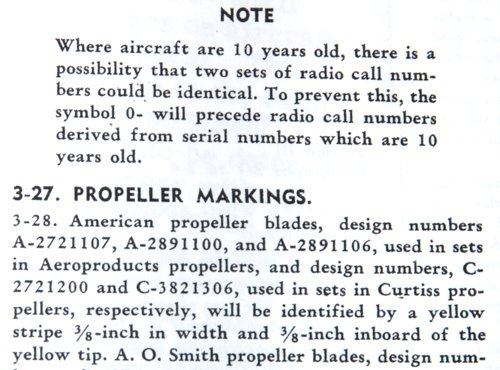
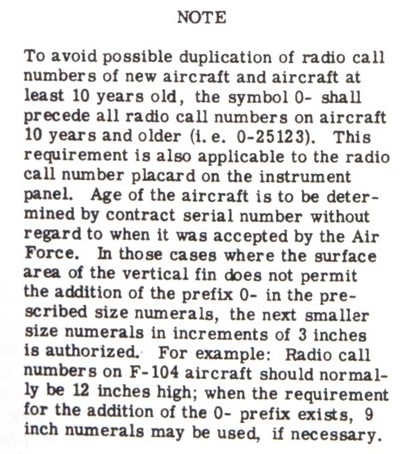
So, when this change came into effect in 1954, C-54E Skymaster 44-9114 saw its tail number changed from '49114' to '0-49114', making it possible for the serial number 54-9114 (new tail number 49114, without this prefix) to be issued for a new aircraft.
Oh or zero?
But was this new '0'-prefix a zero, or was it the letter 'Oh'? This question has caused heated debate among enthusiasts for many years, with the proponents of 'Oh' often claming that it stood for 'Obsolescent', 'Obsolete', 'Old' or 'Over ten'. Even well-known aviation authors were divided over the issue, with some books explaining that the prefix is a zero, and other books that it is an 'Oh'.
Fortunately, the original Technical Order documents use a typeface that clearly differentiates between the zero and the 'Oh'. In other words, by simply comparing the symbol used in the official documents T.O. 1-1-636 (see above) and the newer T.O. 1-1-4 to other zeros and to 'Ohs' on the same pages, it is obvious that the tail number prefix symbol is in fact the numeral zero, and not the letter 'Oh'.
View the relevant page from the original T.O. 1-1-4 to judge for yourself.
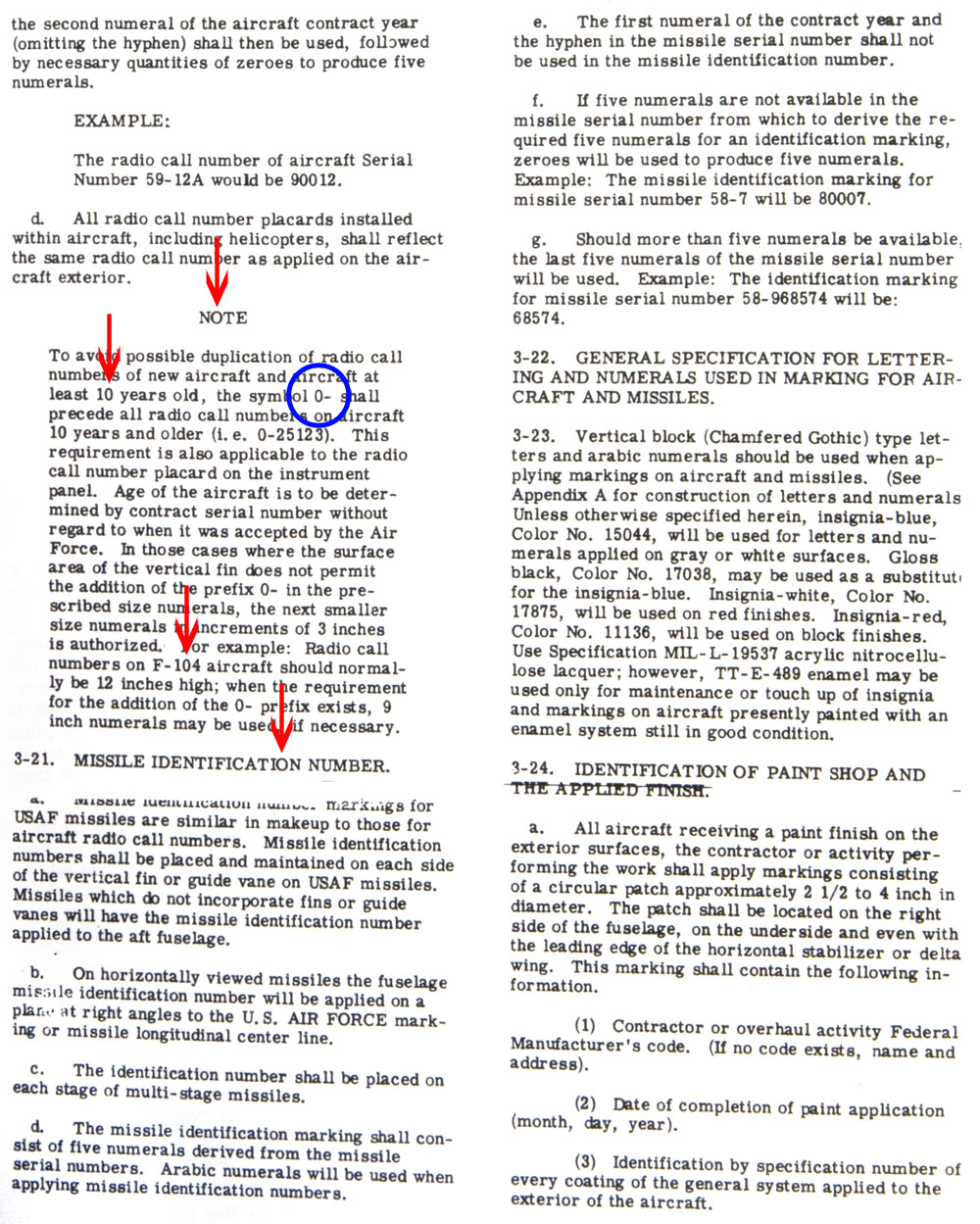
So the symbol used is definitely a zero, and it simply signifies that the aircraft is over ten years old. It is not an 'Oh' and it does not stand for 'Obsolescent' or 'Old'. This 'Oh' versus zero issue may seem trivial to many, but in this digital day and age it is not. To a computer the letter 'Oh' and the numeral zero are distinctly different, and a search for one will not find the other. It is therefore important to get this right.

Starting in the late 1950s, tail numbers were often applied with a maximum of only five digits, against the regulations. The tail number of this JC-47A 43-15983 should have read '0-315983' according to the rules from T.O. 1-1-4. In certain cases, such deviations can make proper identification difficult.
Photo: William T. Larkins (Bill Larkins)
Starting in the late 1950s, tail numbers were often applied with a maximum of only five digits, against the regulations. The tail number of this JC-47A 43-15983 should have read '0-315983' according to the rules from T.O. 1-1-4. In certain cases, such deviations can make proper identification difficult.
Photo: William T. Larkins (Bill Larkins)
On 24 April 1972, eighteen years after its introduction, the requirement for the '0-' prefix was dropped, with no reason given. The text was deleted from T.O. 1-1-4, and the '0-' prefixes were removed from the tail numbers during routine corrosion treatment and paint periods.
This means that today, with aircraft easily reaching a service life of 20 years and more, duplication of tail numbers is very common. In practice, this causes little confusion, because in most cases different aircraft types are involved. The most striking exception are the US Army helicopters, where there are often duplicate tail numbers for the same aircraft types. This may be the reason that the US Army chose to re-introduce the '0-' prefix: some UH-60 Blackhawk helicopters have been known to carry it again.
Buzz numbers
Although the tail number was supposed to make aircraft identifiable from a distance, an even larger serial-based marking, the 'buzz number', was introduced by the USAF in the late 1940s. Arguably replacing the wartime RAF-style squadron codes, the buzz number was so called because the pilots felt its purpose was to allow identification from the ground as to discourage unauthorized low flying or 'buzzing'.
A buzz number consisted of two letters, identifying the aircraft type, and the last three digits of the serial number, painted in a large size on both fuselage sides and under the left wing. For example, the F-86 Sabre was coded FU and 49-1092 (tail number 91092) wore buzz number FU-092. In cases of two aircraft of the same type having the same last three digits in their serial numbers, a suffix letter A was to be added to the buzz number of the later aircraft. The buzz numbers disappeared from USAF aircraft in the years leading up to 1965, and ceased to be mentioned in the January 1965 edition of T.O. 1-1-4.
The 'AF' presentation
In the 'AF' presentation of the serial number, it is the first digit of the sequential number that is omitted instead of the 'decade digit', as demonstrated here by the F-4D Phantom 66-7478. In the 'regular' presentation the tail number would be '67478'.
Photo: Jonathan Verschuuren Collection
Arguably, the buzz number had given way to an alternative presentation of the tail number, which was defined in T.O. 1-1-4, issued 15 July 1959, and first started to appear on combat aircraft fighting in Vietnam. This presentation consists of both fiscal year digits, but in small size, and the last three (sometimes four) of the aircraft's sequential number in large size. This means that instead of the 'decade digit', the first digit of the sequential number is usually left out. The letters 'AF' for Air Force are normally added above the small fiscal year digits, and this presentation is usually combined with a two-character unit code in large size on the tailfin. The Technical Order said this presentation was applicable to 'camouflaged combat support aircraft' to enable aircrew to 'readily identify aircraft to their own unit or to other friendly units.' This 'AF' presentation is found today on many USAF aircraft including uncamouflaged trainers, but the traditional tail number presentation is also still in use, even on camouflaged (grey) transports and tankers.
US Army serials
As mentioned earlier, when in September 1947 the USAF and the US Army became separate branches of the military, the US Army continued to use the same serial system. For many years the USAF and US Army serial number batches were intermingled. But in fiscal year 1966, the US Army decided to separate them by using the fiscal year prefix followed by five-digit sequential numbers starting at 15000 instead of 0001 (e.g. 66-15000). As of fiscal year 1972, the US Army sequential number batches were even higher, in the 20000-30000 range. Oddly, as of fiscal year 1984 the US Army again began allocating four-digit sequential number batches in the old range starting at sequential number 0001 while at the same time also still using allocations in the 20000-30000 range.
In about 2015 some sources suddenly began to claim that five-digit sequential numbers had become the norm in the US Army, and that the lower US Army serial batches should be 'padded' with an extra zero to create them (e.g. 84-00157 instead of 84-0157). It is claimed that this practice dates back to the 1960s (or even to 1947 according to some). However, photographic evidence shows that tail numbers actually painted like this are non-existent for pre-1992 fiscal years, and are very rare for later years. These exceptional cases occur both on Army and USAF aircraft, which strongly suggests that they are due to painting errors.
At the root of the confusion is the way in which aircraft serials are recorded in the Army's computer systems. In 1999 the Department of the Army released Pamphlet 738-751, titled Functional Users Manual for the Army Maintenance Management System – Aviation. Referring to the sequential number as the designated number, this document says in chapter 1, section 1-6, paragraph 7:
Aircraft serial numbers will be recorded without a hyphen or dash between the procurement fiscal year (FY) and the designated number. Aircraft serial numbers will contain only seven numerical characters. In case the serial number contains less than seven numerical characters, add a zero "0" or zeros following the first two characters (FY procurement) of the serial number. For example, serial number 84-23456 will be recorded as 8423456; 85-6789 will be recorded as 8506789; or 90-123 will become 9000123. The entry made on aircraft forms in this format is needed to fit the automation system format.
This document, as indicated by its title, is merely a user manual for the Army's maintenance management system, and the quoted paragraph states how personnel must record the aircraft serial numbers into that system. The last sentence in that paragraph explains the simple reason for that seven-digit format: the Army's early computers were unable to deal with the dash in the serials, or with shorter sequential numbers, and the seven-digit format circumvents this deficiency.
The document does not say that serial 85-6789 becomes 8506789. To the contrary, it says that serial number 85-6789 'will be recorded as 8506789' in the maintenance system. The phrase 'in case the serial number contains less than seven numerical characters' also clearly indicates that the actual serials have not changed, and that serials with less than seven digits do exist. Nevertheless, many US Army inventory lists now only show seven-digit, dash-less serial numbers. Clearly, however, these are not the actual serial numbers, but merely an internal representation of them that suits the US Army's computers.

The correct serial for this US Army RC-12K is 85-0152, not 85-00152 as claimed by several sources. The internal representation of this aircraft's serial in the US Army computer systems is not '85-00152' either, but '8500152'. The painted tail number 50152 is correct and also does not show an extra zero.
Photo: Lewis Grant
The correct serial for this US Army RC-12K is 85-0152, not 85-00152 as claimed by several sources. The internal representation of this aircraft's serial in the US Army computer systems is not '85-00152' either, but '8500152'. The painted tail number 50152 is correct and also does not show an extra zero.
Photo: Lewis Grant
This representation has led to much confusion among enthusiasts and US Army personnel, because it is incorrectly interpreted to mean that all US Army aircraft serials must have five-digit sequential numbers. Most US Army aircraft by far are painted correctly (i.e. no added zero in the tail number), but some aircraft have indeed been painted with tail numbers that show an extra zero.
Full serials
While digesting all the regulations for tail numbers, you may be asking what all these are actually good for, and why they don't simply paint the full serials. One outpost of sanity seems to be the US Army's CH-47F Chinook fleet. Almost all upgraded and new CH-47Fs are painted with their full serial numbers (i.e. not the tail number!) on the aft pylon, including the full fiscal year. The presentation is also unusual in that it partly follows what is discussed above: there is a padding zero to create a five-digit serial (e.g. 08-08049), both on the aft pylon and 'officially' in the data block on the nose, but the dash is not removed.
Rather than a new and more sensible way to present serials, this may well be caused simply by some staffer's own interpretation of Pamphlet 738-751. Recent US Army serial allocations appear to happen in a detached manner, anyway, with many sequential numbers based on construction numbers, while the Army's UH-72 Lakota helicopters have five-digit sequential numbers starting with '72' for the aircraft type. Anything goes, it seems, in today's US Army serials, and as often in the subject matter of this article, the motives behind the decisions are unclear.
It is noteworthy that in the US Air Force, some newer aircraft display their full, six-digit serials too, although without a dash. C-12W Liberty aircraft tend to do this, and some CV-22B Ospreys have their six-digit serials painted on the rear fuselage, with the four-digit sequential numbers repeated on the tail endplates. Whether this is the result of any official policy – an experiment, perhaps – we do not know.
Acknowledgements
This article is based on an internet publication titled The 'Over Ten years' Prefix: Zero or 'Oh'?', by Aad van der Voet. Many thanks go to Bill Larkins, avid aviation enthusiast, photographer, researcher, writer, and founder of the American Aviation Historical Society (AAHS). Bill went to great lengths to contribute suitable historic photos to illustrate the text, for which we are very grateful. Bill Larkins passed away in 2021. You can explore a growing selection of his magnificent photos on the AirHistory.net website.
Sources
- "U.S. Military Aircraft Designations and Serials since 1909", by John M. Andrade (1979 edition)
- "U.S. Military Aircraft since 1909", by Peter M. Bowers (1989 edition)
- "United States Air Force Serials 1946 to 1977", by Peter A. Danby (5th edition, 1977)
- "Buzz Numbers", by Peter M. Bowers and David W. Menard (2006 edition)
- USAF Aircraft 1947-1956>, by James C. Fahey
- USAF Technical Order 07-1-1, issued 28 October 1941
- USAF Technical Order 07-1-1, Revision C, issued 20 July 1954
- USAF Technical Order 1-1-81, issued 15 August 1955
- USAF Technical Order 1-1-63, issued 11 January 1956
- USAF Technical Order 1-1-4, issued 15 July 1959
- USAF Technical Order 1-1-4, issued 14 May 1994 - Change 7 issued 17 July 1998
- Department of the Army, Pamphlet 738-751,"Functional Users Manual for the Army Maintenance Management System – Aviation", dated 15 March 1999 (277 pages)
- Department of the Army, Pamphlet 738-751,"Functional Users Manual for the Army Maintenance Management System – Aviation", dated 28 February 2014 (189 pages)
